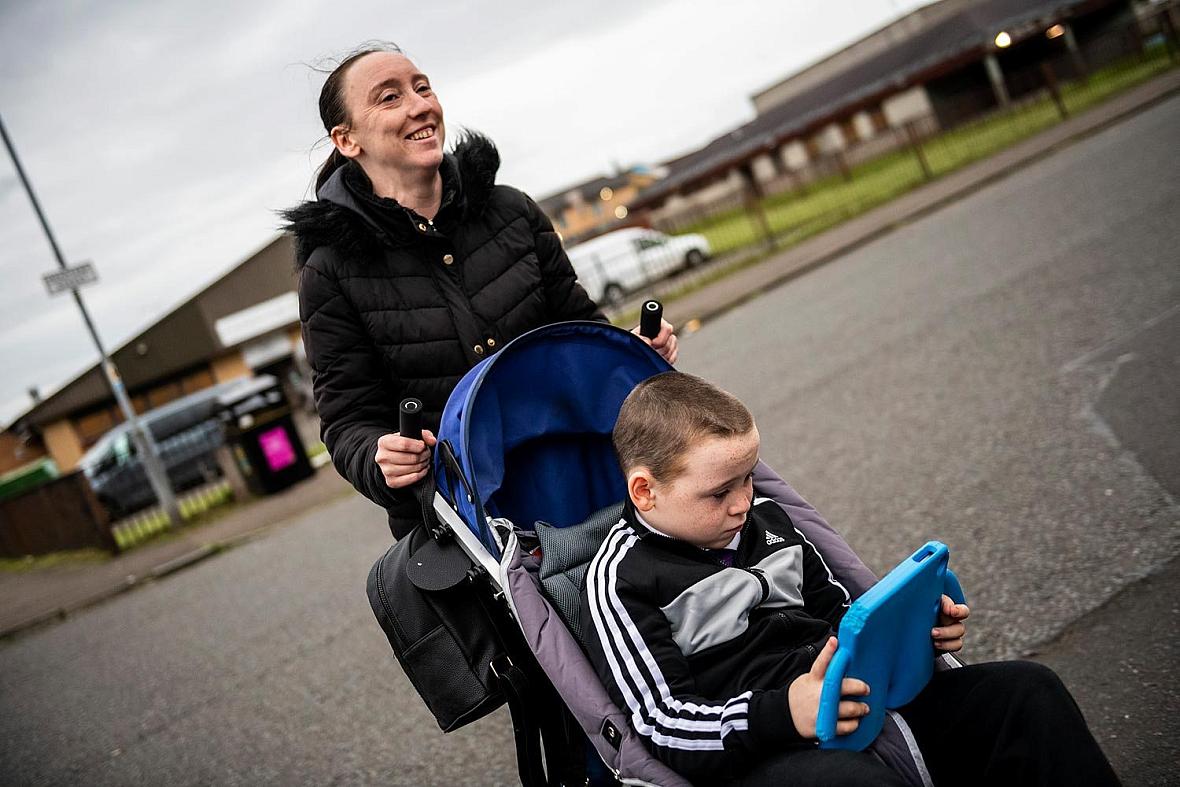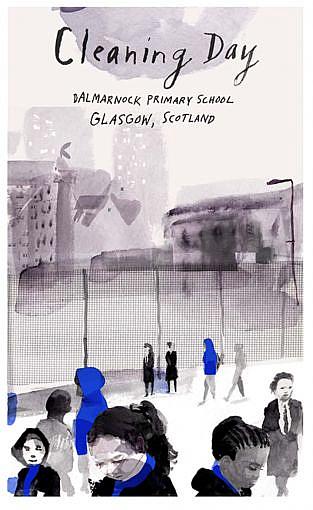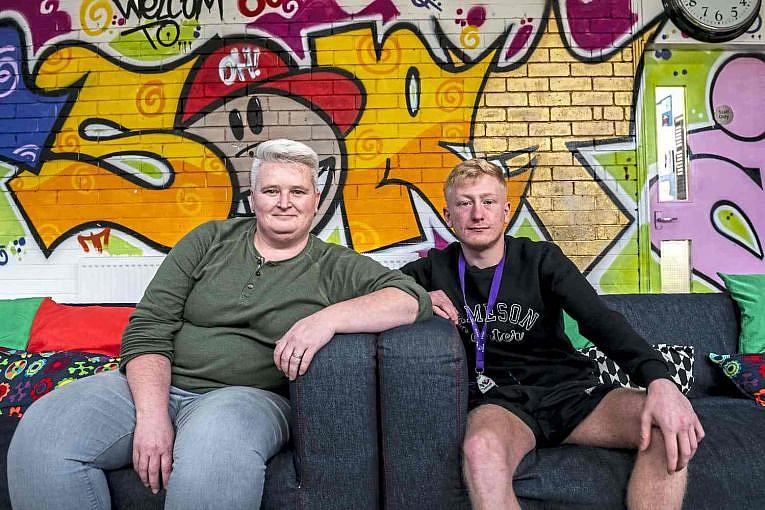A Wee Spark of Hope
This story was produced as part of a larger project led by Rich Lord, a participant in the USC Center for Health Journalism's 2018 Data Fellowship.
Other stories in this series include:
Charges lodged in North Braddock arrest
Growing up through the cracks: The children at the center of North Braddock's storm
Where fighting poverty is a priority
Pittsburgh's neighborhood boosters face changing landscape
Current and former Rankin residents remember the past, envision the future
Rankin, Pennsylvania: Fighting 'the depressed mindset'
Growing Up Through the Cracks: Mapping Inequality in Allegheny County
A mother moves from McKeesport to Glassport to try to better her family’s chances
Growing up through the cracks: North Braddock: Treasures Amid Ruins

GLASGOW, Scotland
The death of a loved one set Leanne Quigley adrift, and a decade later she’s still surprised that she laid anchor in Possilpark, a neighborhood that taxi drivers and statisticians alike call the United Kingdom’s harshest.
Reeling from that death, she and her daughter joined family in the dense public housing blocks of Possilpark, and then she birthed a son.
“I’ve been in Possil ever since,” the 32-year-old, unemployed single mother said, as her 7-year-old David rushed into the community center room with his iPad, demanding, “Fix it!”
“I never, ever thought I would see them growing up in Possil and me living in Possil.”
But here she is, with a son affected by autism and a daughter, Chloe, approaching her teens, in a place that brings despair to Glasgow’s veteran anti-poverty campaigners.
Like the kids featured in the Pittsburgh Post-Gazette’s yearlong series “Growing Up Through the Cracks”, the wee ones or “weans” of Possilpark come up surrounded by poverty and weighed down by low expectations.
The difference is that Glasgow’s government pledged a decade ago to work with its poor, and Scotland’s parliament voted two years ago this month to do everything it can to all-but-eliminate child poverty by 2030. There is no comparable commitment by the U.S., Pennsylvania or Allegheny County.
Glasgow’s pledge and Scotland’s declaration make this city a test case for those in the developed world who want to lift kids out of poverty. It’s hard to imagine Scotland passing that test — and thereby sending a message of hope to places of high child poverty like Pittsburgh, the Mon Valley and Fayette County — without addressing Possilpark.
"Nae future for the weans in Possil"
As October waned, a dozen of Glasgow’s anti-poverty campaigners gathered over tea and cookies, and sure as the sky was gray, talk turned to Possilpark.
This group, dubbed the Poverty Truth Community, includes veterans of a movement that stormed Glasgow City Council in 2009, and then successfully pushed for changes to the city’s handling of violent crime, foster care and school uniform subsidies. But those assembled in a former church near Glasgow’s center saw little cause for optimism about Possilpark.
“Possilpark’s just a lawless community,” said Jean Forrester, a Poverty Truth Community member who hails from that neighborhood and described herself as the mother of two survivors of addiction. “You can’t move these young weans that are selling drugs.”
“There’s nae future for the weans in Possil,” agreed Charlie Harkins, who said he caught a cocaine habit while living there and did time for stashing drugs.
”There’s nae hope in Possil,” he added. But later he noted that his stepdaughter and her 10-year-old daughter still live there, and conceded “a wee spark of hope.”
"Tweet, Tweet, Possil Fleet, Steals the Trainers off Your Feet"
Hop a cab for Possilpark, and the cabbie inevitably raises his eyebrows, then lets you know he’s collected many a fare delivering drug seekers to its low-income housing complexes with nicknames like The Jungle.
The road to The Jungle will seem familiar to Pittsburghers.
Around 150 years ago, Possilpark changed rapidly from farmland to factories when a new railway attracted the Saracen Foundry ironworks. In 20 years, Possilpark’s population exploded from 10 to 10,000 (where it remains), as housing, schools, cinemas and shops followed the jobs at the foundry and its spinoff factories.
The foundry closed in 1967, leaving vast brownfields and few jobs. By the 1980s the neighborhood was the hub of Glasgow’s heroin trade. A sports facility dubbed the Millennium Centre failed, was vandalized and burned. Now the shopping artery of Saracen Street features pubs, bookies and a pharmacy that draws a morning queue of methadone users.
Studies show that Glasgow’s Canal Ward, which includes Possilpark, has been the most persistently deprived area in the United Kingdom, which includes England, Scotland, Wales and Northern Ireland.
From the outside, the squat, 38-year-old Possilpoint Community Centre, wearing a crown of metal thorns designed to keep youth from mounting its roof, affirms that impression.
Within its cinder block walls one late afternoon, a handful of neighborhood crusaders mulled the prior night’s hooliganism, which saw a bicycle gang “setting off fireworks on Saracen Street and aiming them at the cars that were driving by,” rued Ann Lawrance, project manager of the nonprofit Young People’s Futures.
YPF formed after a 2002 gathering at which 200 of the neighborhood’s youth said, as Ms. Lawrance recounts, “We have nothing to do, nowhere to go.”
She says her team then “stole” the initials from a gang called Young Possil Fleetol — that last word a local term for crazy people. It took its sneaker-shaped logo from the neighborhood rhyme “Tweet, tweet, Possil Fleet, steals the trainers off your feet.”
Now staff and young apprentices like Kelsey Reilly, 19, lead arts and crafts sessions, organize gym games, help out in the computer room and cook dinner for kids in the cafe.
“People expect that they already know what Possilpark is, and they think that it has this bad reputation, they don’t like it, they don’t want to have anything to do with it,” said Ms. Reilly, who is accumulating experience while awaiting responses to her five university applications. “But when you’re actually here, especially in the community center, you see the potential of all of the kids, and what they can be.”
The Jungle isn’t as wild as it used to be. The fleetols now rarely square off with police, and the heroin trade is less public. But knife crime is prevalent, and people are dropping from “street valium” — black market narcotics pressed into pills, and sometimes taken in combination with heroin or methadone. Glasgow’s fatal overdose rate has spiked to rival Allegheny County’s in 2017, when fentanyl drove record deaths.
“A lot of the young people, all they aspire to be is drug dealers,” said Frank Law, who manages YPF’s family support service. “We cannae save everybody. [The drug problem has] been here since day dawn. It’ll be here in day dash.”
Cleaning Day: Dalmarnock Primary School, Glasgow, Scotland
by Stacy Innerst

“If We Say ‘Why Bother,’ Then Why Should Communities Bother?”
Glasgow is a city of around 600,000 in a region of 1.2 million — the largest in Scotland, a nation of 5.4 million. In April, Glasgow’s government reported that 34% of its kids lived in poverty. That’s not far different from Pittsburgh’s reported figure. In two Glasgow wards (Canal and Calton) more than 40% of kids were in poverty, comparable to much of the Mon Valley, parts of Fayette County and some river towns of Westmoreland and Armstrong counties.
The Child Poverty [Scotland] Act of 2017 demands that the national government, its municipalities and the National Health Service collaborate to virtually wipe out child poverty by 2030.
In its bid to meet that deadline, Scotland boosted funding for schools in poor areas, filled in gaps in the United Kingdom’s benefits system and soon plans to start paying low-income families 10 British pounds ($13) per week per child. The government also pays all college tuition.
The National Health Service, meanwhile, has launched or expanded programs like the Money Advice Service at Glasgow’s Royal Hospital for Children, and Cafe Stork for new mothers.
Glasgow City Council is backing free nursery care and preschool for low- and moderate-income families, activities plus meals for kids when school isn’t in session, and a school uniform subsidy for needy families.
It’s all paid for with taxes on upper-middle and upper incomes that are a few percentage points higher than those in the rest of the United Kingdom, said Glasgow City Council Leader Susan Aitken.
“There is an understanding that if those who can pay more [do] pay a bit more, everybody benefits,” said Ms. Aitken, a member of the Scottish National Party. “This is building a society where we bring as many people with us as possible.”
Scotland’s effort comes as the London-based central government, under Conservative Party leadership, reworks the overall benefit structure in what Ms. Aitken calls a “constant bombardment of the poor by the U.K. government.” By some estimates, the U.K.’s benefit cuts are expected to push more children into poverty, despite Scottish efforts to the contrary.
“It’s absolutely right that we set ourselves those targets and we set ourselves those ambitions and aspirations as a nation and as a city. We need to try and do it,” Ms. Aitken said. “I don’t think we can say that they’re an impossibility, because if we concede that, then we end up going, ‘Why bother?’ If we say ‘why bother,’ then why should communities bother?”
Ned (N) Scottish Slang for Non-Educated Delinquent
Jason Smith used to show up at events with the intention of getting kicked out — especially when the youth group Y Sort It was involved.
“They used to try to engage me and I’d come to their groups and I’d smash them up. I would fling stuff at their cars,” said Mr. Smith, as a rare bit of late October sunshine pierced a window in West Dunbartonshire, just west of Glasgow. “I’d swear at them, be cheeky at them, fling apples.”
He did that, and more, just for what he calls “the butterflies” — that feeling in the gut that accompanies an adrenaline rush and relieves boredom. His crew would meet on the “motorway” and fight with rival gangs, he said, with a grin. “People might get hit by cars, running away from getting stabbed.”
He came of age in a place that was to shipbuilding what Homestead was to steel. Like the smokestacks at The Waterfront, West Dunbartonshire has its signature relic: a blue crane called Titan that evokes nostalgia for some, but reminds others that they were born too late for the good times.
In his mid-teens, Mr. Smith built his reputation as “quite a dodgy boy” and drifted into dealing and using cocaine, becoming a “ned” in a spiral of drug debt. But Y Sort It coordinator Gillian Kirkwood “kept giving me a chance,” he said, and she finally shocked him by offering him a job running the events he used to disrupt.
Gillian Kirkwood, Y Sort It coordinator, left, and Jason Smith, a youth worker with Y Sort It, sit in the organization’s lounge in Clydebank. Image by Michael Santiago. United Kingdom, 2019.
Seven years later, at age 23, he gets the butterflies counseling troubled kids. “I’ll be full of laughs even if I’ve had a rubbish day.”
Y Sort It — the latter words U.K. slang for putting things in order — is directed by people 25 and under. It mentors kids, refurbishes bicycles, paints murals, organizes youth sports and advocates for things like a new 216,000 pound ($287,000) soccer field.
It’s funded in part by the West Dunbartonshire Council, which oversees towns totaling around 92,000 people that stretch from the postindustrial banks of the Clyde River to the edge of scenic Loch Lomond.
West Dunbartonshire can back groups like Y Sort It because — unlike the Mon Valley’s cities and boroughs — it doesn’t have to limp along on local property taxes.
Scotland is a nation within the United Kingdom, with limited powers over its own taxation and spending, much like a state in the U.S. In Scotland, the national government funds 80-85% of local government and school costs. Compare that to Pennsylvania, in which the state pays for an average of 22% of municipal government and 40% of public education.
As a result of national funding, there’s no hint of disadvantage at the 12-year-old Dalmarnock Primary School, in Glasgow’s Calton Ward, where half of children are in poverty. Teacher salaries, utilities and capital improvements are all paid by the Scottish government. And three years ago the government launched the Scottish Attainment Challenge — an effort to close the education gap between schools in low-income and high-income areas, backed by an extra 1,200 pounds ($1,543) for each student who is eligible for free lunch. That has made budgeting “quite easy,” said Nancy Clunie, head teacher at Dalmarnock Primary.
The school also benefits from the new Children’s Neighbourhoods Scotland project, which aims to coordinate services and give voice to kids in disadvantaged areas.
“It’s really about providing and trying to create a society where everybody has an equal opportunity to fulfill their potential,” said Chris Chapman, a professor at the University of Glasgow and the principal investigator for Children’s Neighbourhoods Scotland.
At Glasgow’s Sacred Heart Primary School, where Children’s Neighbourhoods Scotland launched the first of several student groups, 11-year-olds Lucy Cia MacIntyre and Hanford Frimpong debated the best course for spurring improvements in Calton Ward.
“You’ve got to go to Theresa May, but she sits in her office all day, eating biscuits,” said Lucy.
“First of all, she quitted, and Boris Johnson is the prime minister now,” Hanford corrected.
“Right,” said Lucy. “Boris Johnson should not be the prime minister.”
“Right now they’re pursuing Brexit and voting, so right now first of all we’re going to have Brexit,” said Hanford.
“I should be prime minister,” said Lucy.
"Stay Away From Her"
It would be wise to keep the camera hidden, a cabbie warned, and with daylight getting short any stay in Possilpark should be brief.
Possilpark residents know they live in a stigmatized place. When Ms. Quigley used to socialize in other neighborhoods and told people she was from Possil, “they would go, ‘Stay away from her.’ Because it’s just such a bad name.
“Obviously there’s been a lot of deaths through drugs and stuff in Possil,” she admitted.
In the enclosed backyard of her subsidized apartment, though, David shouts “weeeeee!” as he runs circles around a sensory garden built for free by Ms. Quigley’s cousin. The fence is festooned with musical toys and hung with lights, the floor is a mix of soft blue and green artificial turf and other textures, and it’s all gently perfumed by a stand of fragrant herbs.
Daily Ms. Quigley starts there, then puts David in a large stroller and pushes him the three-plus blocks to Possilpoint. She pays Young People’s Futures 50 pence ($0.64) per session per kid — except in the summer, when it’s free.
One dim evening, as Chloe pasted her hopes to a “vision board” with an arts and crafts group, David stripped off his tennis shoes and raced around the gym, holding high his iPad in its soft, blue case. “There’s normally a bouncy castle in there,” Ms. Quigley said, explaining the shoes.
“He’s so full of life, honestly. Constant, he is,” Ms. Quigley said of David. “Just a great wee boy.”
Considered nonverbal until recently, he has started to ask simple questions (“Where’s Chloe?”), identify shapes (“Heptagram!”) and high-five other kids at Possilpoint.
“I think [David] would probably still be quite in his shell if I was not bringing him,” Ms. Quigley said.
YPF, though, limps along on around 300,000 pounds ($386,000) a year, cobbled together from charitable grants and government funds, including an allocation from Glasgow’s participatory budgeting process, in which communities control some of their own funding.
The building it rents from the city is “not very pretty. It looks quite dull. It’s really small and the ceilings are very low,” noted Ms. Reilly, the 19-year-old Possilpark resident and YPF apprentice.
Ann Lawrance, though, had a bit of news. A coalition of five organizations, called the Possilpark People’s Trust, just landed a 1.5 million pound ($1.9 million) commitment from the U.K.’s National Lottery, putting it “on our way to building a new community facility.”
The 18,000-square-foot building will cost 4 million pounds ($5.1 million), replacing a polluted and fenced-off field and freeing up space for a new soccer pitch.
“That’s amazing that they’re going to do that,” said Ms. Reilly.
She hopes to study child psychology and bring that expertise back to Possilpark. She’s encouraged by a country and city that seem determined to do right by the children — no matter their family income.
“It will be an area that people want to live in, that people want to be a part of and involved in,” she predicted. “It’s happening, and it’s still got a lot that it has to go through, but it’ll get there.”
Ms. Quigley thinks her “supports” in the neighborhood will buoy Chloe and, especially, David. “I’m betting that by next year I’ll actually be seeing even bigger progress,” she said of her son.
“A lot of people say that Possil is terrible,” she said, as she connected David’s iPad to Wi-Fi, “but actually I make the best of it that I can.”
[This article was originally published by the Post Gazette.]

